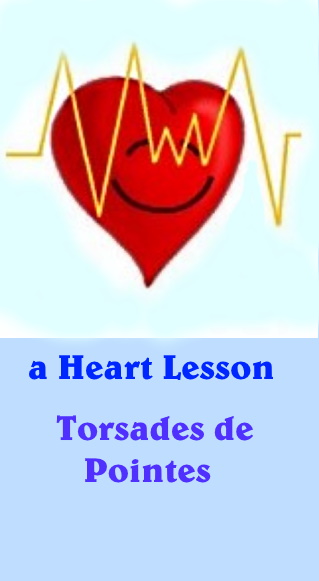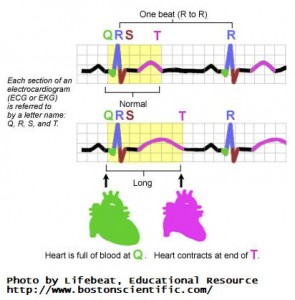
A healthy heart as we know is a pump that delivers oxygenated and de-oxygenated blood for our bodies to survive.
Our hearts can contract up to 2.5 billion times during a person’s average life. We recognize the heart as one of the most major organs since without it, there’s no life.
Unfortunately, one can be born or acquire ailments that affect our heart, such as ‘Torsades de Pointes‘.
Learning Heart Arrhythmia
Torsades de pointes refers to a dangerous arrhythmia of the heart. It’s usually not diagnosed or treated correctly, and still a somewhat, difficult condition to identify. Arrhythmias are viewed as a disorder in the normal rhythm and rate of the heartbeat.
Studies have revealed common characteristics of this condition for improved care and treatment depending on which variation exists. These variations refer to congenital or acquired torsades.
Types of Torsades + Heart Rates
Inherited Torsades is due to an inability for ‘ion channels‘ to correctly carry the electrical action/impulse of the heart and acquired version refers to drugs triggering Torsades due to ‘blocking‘ these ion currents. Ion channels describes the flow and rate of electrolytes, sodium and potassium in the heart.
Torsades in action has the heart in a state of ‘polymorphic ventricular tachycardia’. This refers to the heart rate increasing to 150 beats per minute (bpm) and up to 250 bpm. A normal heart rate is anywhere from 60 to 100 bpm.
Athletes can have lower heart rates than 60 bmp. This abnormal heart rate will ‘spontaneously‘ return to a normal beat but can recur and/or progress into ‘ventricular fibrillation ‘(VF) symptoms which can lead to death, if it persists. It is this ‘return to normal‘ action that has made identifying Torsades difficult.

Onset Signs and Symptoms
Medical research and studies have shown that people with Torsades have their beginnings with ‘fainting‘ due to a drop in blood pressure causing dizziness . Use of an electrocardiogram (ECG) have revealed a ‘long QT interval’ and another term, ‘Long QT Syndrome‘ (LQTS).
A recording of the heart rate may not reveal Torsades in action but definitely that ‘long QT’ or ‘short variant‘ characteristics of Torsades, help provide clues for physicians and health care professionals.
An ECG showing Torsades in action displays an illusion of a swirled rotation (like a ballet dancers’ pirhouette hence it’s name Pointes) on it’s electrical axis, a long and short RR – interval precedes the arrhythmia and follows a premature ventricular contraction (R-on-T PVC). Other symptoms reported are palpitations, rapid pulse, nausea, cold sweats, lightheadedness (short episode) and outright fainting.
Where Torsades gets Found
Torsades is usually found in people that are malnourished, chronic alcoholics, or with hypokalemia (abnormally low potassium), diarrhea, and/or hypomagnesemia (abnormally low magnesium), heart failure, left ventricular hypertrophy (enlarged left ventricle), bradycardia (slow heart rate), hypothermia and subarachnoid hemorrhage.
It is these symptoms and existing disorders that are critical for a physician or health care team to be aware and identify quickly especially before giving medications, known to trigger Torsades.
Torsades can be found in many age groups. When identified in children, it is congenital and may accompany disorders such as Jervell and Lange-Nielsen syndrome, Romano-Ward syndrome and triggered by effects of stress, fear or physical exertion (usually prohibited from competitive sports), whearas in adult years, it is considered acquired.
Treatment and Outcomes
Electrolyte disorders are usually the cause of acquired Torsades and treatable with correcting the imbalance and/or removal of triggering medications.
Treatment for Torsades is available and it’s known there are six different variants of Torsades. Effective treatment will depend on identifying the specific ‘genotype‘ which identifies whether it’s sodium or potassium channels that are affected.
A family physician may refer their client to a cardiologist, electrophysiologist, or geneticist. Again, failure to identify Torsades has been due to it’s ‘return to normal’ activities and complications of persistent ‘ventricular fibrillations‘ that arise.
Continuous Medical Research
The existence of Torsades has been known for a few years, and further studies at the molecular and cellular levels have provided leaps forward in better care and treatment. The ‘prevalence‘ of Torsades in the general population is an unknown. Could this be a cause of death for the homeless, mentally or medically challenged people, that have occurred when getting tasered by police?
Learning in Motion
Further Learning Resources
Drugs with Risk of Torsades de Pointes
I hope you found this article informative. Please feel free to leave your comments and Share your friends and family. Use the ‘Ask a Question’ form and Send me request on a topic of interest you have, or to say hello.
All rights reserved by AIC|An Informal Cornr. Ginsense creates and posts articles about business development, micro business, health, science, technology and society.
